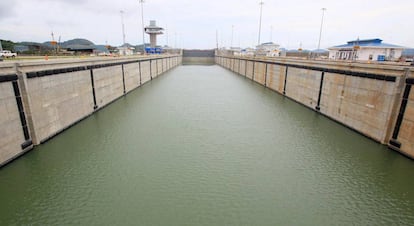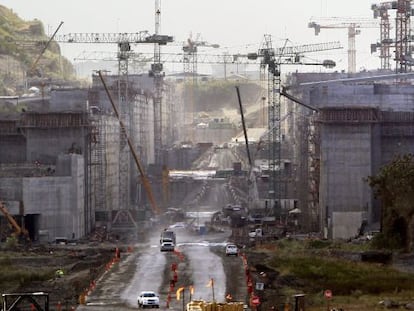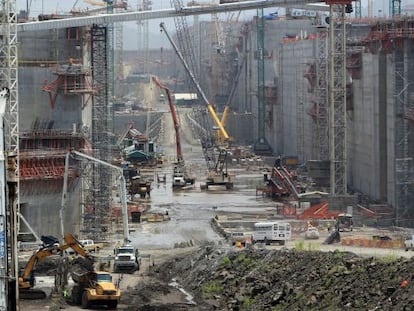New Panama Canal set to open, but builder unsure how much it will earn
Spanish-led consortium that built expansion trusts it will reach a deal over cost overruns


The Spanish-led consortium working on the expansion of the Panama Canal is planning to hand over the completed project on May 31, after suffering major delays and cost overruns.
But the Grupo Unidos por el Canal (GUPC) consortium, which is headed by Spanish company Sacyr, still does not now how much money it will receive for what it terms “the biggest engineering project in the world.”
That is because a legal battle is still underway to decide the price of the construction work. Depending on what a Miami arbitration court decides, the project could mean losses for the builders.
When ships start to transit through the new canal it will be easier to negotiate a happy ending
Sacyr chief Manuel Manrique
Consortium leaders told a group of Spanish journalists in Panama that “it is going to be very difficult for this project to make money.”
The expansion of the century-old waterway was awarded to GUPC in 2009. The project had an initial budget of $3.2 billion (around €2.85 billion), but Sacyr says that the costs have spiked to €5.58 billion, triggering company demands for more money from Panama Canal authorities.
So far, the contractors – which also include Belgian, Italian and Panamanian companies- have managed to get an additional $460 million provisionally recognized as due, although Spanish sources said they expected to ultimately receive around 50% of their cost overruns.
The Canal in numbers
The Panama Canal Authority estimates that traffic will increase from 350 million tons a year to 600 million. Nearly 14,000 ships currently cross the canal annually, in a journey that takes between 18 and 20 hours.
The expansion involved 11,000 workers from 40 countries, 4.5 million m3 of concrete, and 220,000 tons of steel – as much as was used on the Eiffel Tower.
This excess expenditure was caused by the quality of the basalt, unexpected problems with the terrain, worker strikes and regulatory changes. The consortium has claimed that the Panamanian authorities provided them with inaccurate geological studies that downplayed he real building difficulties.
Sacyr chief Manuel Manrique said he is convinced that GUPC and the government of Panama will reach a reasonable agreement, and underscored that the expansion of the waterway has been “a success story.”
“We are working to initiate a process, and when ships start to transit through the new canal it will be easier to negotiate a happy ending,” said Manrique at a press conference.
Manrique also said that the agreement did not have to be exclusively financial, and that other types of compensation could be sought. The chairman of Sacyr would not advance a date for the completion of this deal.
Also present at the conference was Carlos Espinosa de los Monteros, the High Commissioner for the Spain Brand, who underscored the project’s importance as a way to showcase the ability and technology of Spanish construction firms in the world.
Over 100 vessels have already booked dates to make the crossing between the Atlantic and the Pacific between now and September
The Spanish representative said that the real significance of the project resides in its sheer scope, and insisted that relations between both countries have not deteriorated over the legal dispute.
Although the completion date is May 31, the inauguration of the new Panama Canal will not take place until June 26, coinciding with general elections in Spain. This means that acting prime minister Mariano Rajoy will be unable to attend.
Nearly 70 heads of state and government have been invited to come witness the crossing of the first ship, a container barge named Andronikos owned by the China’s COSCO.
The new locks built by the consortium will allow the passage of triple E class ships, a type of very large container ship. Over 100 vessels have already booked dates to make the crossing between the Atlantic and the Pacific between now and September.
English version by Susana Urra.
Tu suscripción se está usando en otro dispositivo
¿Quieres añadir otro usuario a tu suscripción?
Si continúas leyendo en este dispositivo, no se podrá leer en el otro.
FlechaTu suscripción se está usando en otro dispositivo y solo puedes acceder a EL PAÍS desde un dispositivo a la vez.
Si quieres compartir tu cuenta, cambia tu suscripción a la modalidad Premium, así podrás añadir otro usuario. Cada uno accederá con su propia cuenta de email, lo que os permitirá personalizar vuestra experiencia en EL PAÍS.
¿Tienes una suscripción de empresa? Accede aquí para contratar más cuentas.
En el caso de no saber quién está usando tu cuenta, te recomendamos cambiar tu contraseña aquí.
Si decides continuar compartiendo tu cuenta, este mensaje se mostrará en tu dispositivo y en el de la otra persona que está usando tu cuenta de forma indefinida, afectando a tu experiencia de lectura. Puedes consultar aquí los términos y condiciones de la suscripción digital.
More information
Archived In
Últimas noticias
Cubans look to Venezuela fearfully after Trump’s incursion: ‘We could be next’
The operation in Venezuela to capture Maduro threatens to widen the cracks in the MAGA movement
Trump clarifies who is ultimately in charge in Venezuela: ‘Me’
Maduro pleads not guilty before the federal court in New York: ‘I am still the president of Venezuela’
Most viewed
- Alain Aspect, Nobel laureate in physics: ‘Einstein was so smart that he would have had to recognize quantum entanglement’
- Gilles Lipovetsky: ‘If you want to live better and fall in love, take Prozac, don’t look to philosophy’
- Alvin Hellerstein, a 92-year-old judge appointed by Bill Clinton, to preside over Maduro’s trial in New York
- Cuba confirms death of 32 of its citizens in the US attack against Venezuela
- Why oil has been at the center of Venezuela-US conflicts for decades










































